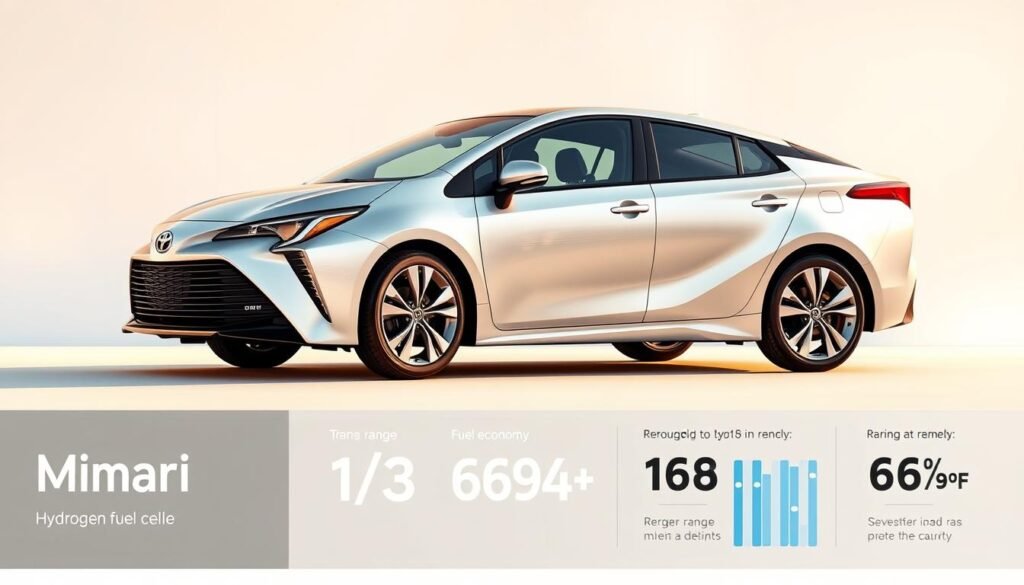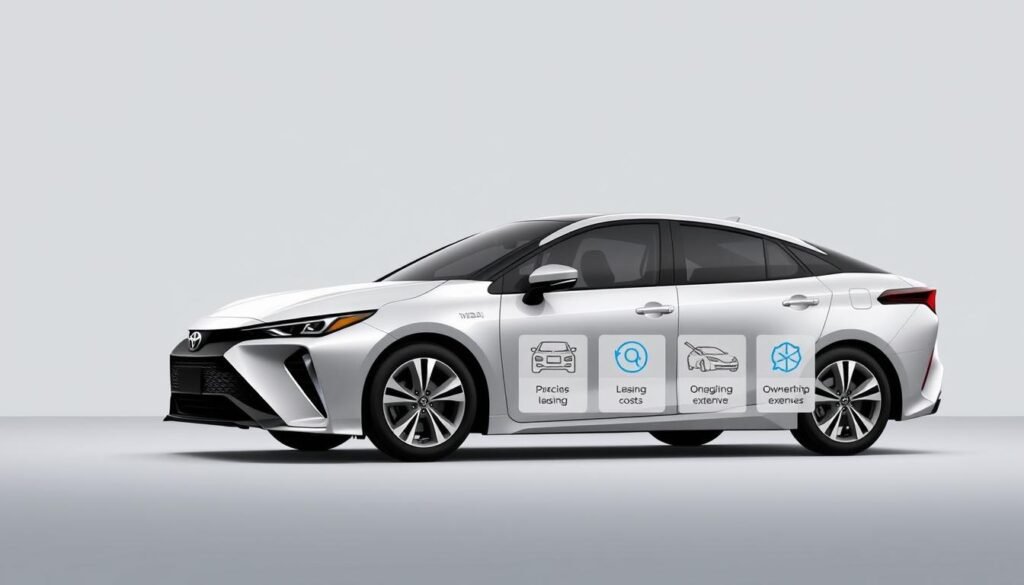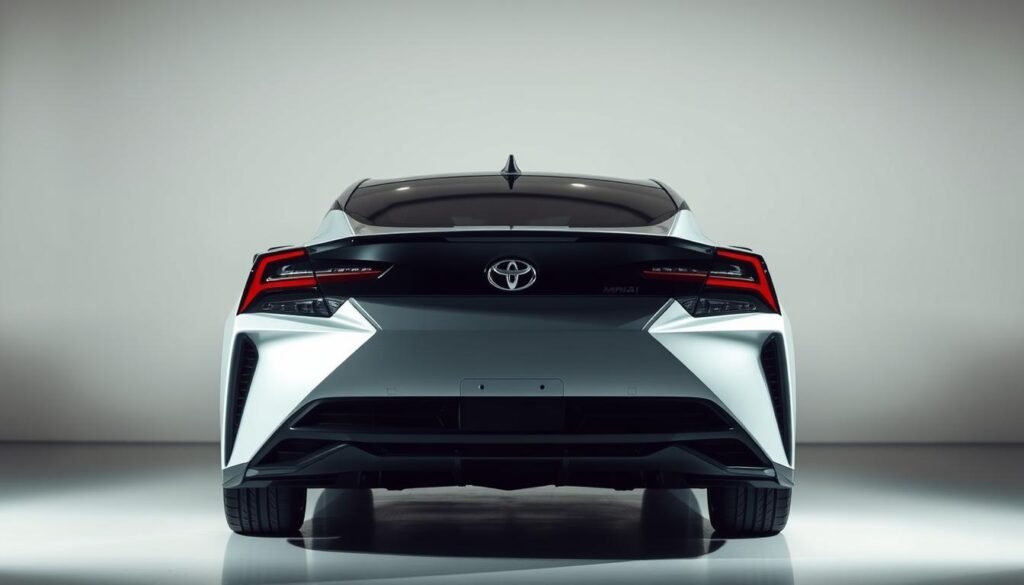One kilogram of hydrogen has about three times the energy of a kilogram of gasoline. The Toyota Mirai uses this energy for smooth, electric drive with no emissions. This review aims to make understanding the Toyota Mirai easy and friendly for Americans.
This Toyota Mirai review covers the basics. It starts with how the car uses hydrogen and oxygen for electricity. It also talks about quick refueling and a quiet ride. The car has an EPA-estimated range of up to 402 miles and is known for its rear-wheel drive and 182 hp from the Toyota Fuel Cell Stack.
The interior is upscale and calm. It features a 12.3-inch Toyota Audio Multimedia touchscreen with voice activation and Premium Audio by JBL. Safety is a big focus, with Toyota Safety Sense 3.0 and carbon-fiber-reinforced tanks. For more details, see the official Toyota Mirai overview.
There are also benefits for buyers and lessees. They might get free hydrogen worth $15,000 for a certain period. This review will dive into performance, range, refueling, warranty, and if owning a Toyota Mirai is right for you.
Overview: Hydrogen Fuel Cell EV Explained
A modern hydrogen fuel cell EV converts compressed hydrogen into electricity on demand. It offers smooth, quiet power and easy refueling. Toyota uses proven parts and fuel cell safety layers to ensure steady performance and confidence.
How a fuel cell stack generates electricity from hydrogen and oxygen
The Toyota Fuel Cell Stack combines hydrogen from tanks and air into thin cells. An electrochemical reaction splits hydrogen, sending electrons to power the drive motor. This is often called the Toyota Mirai engine.
There’s no combustion, so heat is managed by coolants and smart controls. This results in efficient power for city driving and highways.
Zero tailpipe emissions with water as the only by-product
This setup makes a zero-emissions vehicle at the tailpipe. The only by-product is water vapor emissions, released as a light mist. There’s no CO2 or smog-forming exhaust, keeping air fresh and neighborhoods cleaner.
Drivers can also trigger a brief purge to clear moisture after parking. This keeps the system ready for the next trip.
Hydrogen storage in carbon-fiber-reinforced tanks and safety design
Hydrogen is stored in high-pressure, carbon-fiber-reinforced tanks. These tanks are strong and durable. Multiple sensors monitor lines and valves, shutting the flow and venting hydrogen upward if a leak or collision is detected.
The reinforced shell meets global standards. It works with the Toyota Fuel Cell Stack and the Toyota Mirai engine layout. This protects passengers while preserving range and quick refueling convenience.
Toyota Mirai
The Mirai is Toyota’s top Fuel Cell EV. It shows how a sleek sedan can offer electric driving without needing daily charging. It’s perfect for long trips and quick refueling, all while being quiet and luxurious.
Those looking at Hybrid EV, Plug-in Hybrid EV, or Battery EV will see the Mirai as a unique choice. It asks if the Mirai is a good car for everyday use, where time is important and emissions need to be low.
Position in Toyota’s electrified lineup (Hybrid, Plug-in Hybrid, BEV, FCEV)
The Mirai fits well in Toyota’s lineup. It offers efficiency like Hybrid EVs, flexible charging like Plug-in Hybrid EVs, and home-based fueling like Battery EVs. Its fast hydrogen refueling and zero emissions make it a standout choice.
Rear-Wheel Drive dynamics for a refined, engaging ride
Rear-Wheel Drive makes the Mirai balanced and responsive. It supports smooth starts, confident turns, and a stable ride on the highway. Drivers love the quiet cabin and stable feel, making long trips a breeze.
Who it fits: early adopters, luxury seekers, and eco-conscious drivers
Early tech adopters will appreciate the Mirai’s advanced tech and quick hydrogen refueling. Luxury seekers enjoy its quiet, high-end features. Eco-conscious drivers find a way to drive electric without worrying about range, often asking if the Mirai is good for their daily and weekend drives.
For many, the Mirai is the top sedan choice among SUVs and crossovers. It offers the benefits of a Fuel Cell EV while fitting well with other Toyota electric options.
Performance and Driving Dynamics
The Mirai offers smooth driving and confident handling. It has electrified performance that is both calm and eager. Its chassis is tuned to reduce harshness and keep the body stable.
The car’s weight is almost evenly distributed, making steering precise. As a rear-wheel drive sedan, it connects with the road naturally. This makes driving smooth and rewarding.
Toyota Fuel Cell Stack output and smooth electric propulsion
The Toyota Fuel Cell Stack powers an electric motor. This setup creates instant torque without any vibration. It results in a quiet, smooth power surge perfect for daily driving and long trips.
This power delivery is linear and relaxed. It gives the driver instant power when needed.
Estimated 182 hp with responsive acceleration and balanced handling
The Mirai is estimated to have 182 hp. This is a great balance for quick acceleration and controlled driving. The suspension and low center of gravity work together for smooth handling.
Braking feels consistent, helping the driver navigate corners accurately.
City agility and highway confidence powered by RWD
In city streets, the Mirai’s quick torque and compact size make it easy to maneuver. Its turning response is sharp. On highways, the rear-wheel drive sedan stays steady and composed.
This combination shows electrified performance that’s smooth in the city and stable at high speeds.
Toyota Mirai Range and Fuel Economy
Toyota promises you can go farther with fewer stops. The Toyota Mirai range is top among zero-emission sedans. It offers smooth, quiet rides with consistent performance.

EPA-estimated range up to 402 miles on a full tank
The sedan can go up to 402 miles on a full tank. This rivals many gas models for distance. It makes daily drives and weekend trips easy and predictable.
Fuel efficiency equivalence: 3.1/3.3 L/100 km (city/hwy) reference
International buyers often look at fuel consumption. The Toyota Mirai’s fuel economy is about 3.1 L/100 km in the city and 3.3 L/100 km on the highway. This makes it competitive with hybrids or battery-electric models.
Cold-weather and long-distance advantages over some BEVs
Winter trips can be tough on batteries, but hydrogen stacks perform well in cold. Fast refueling keeps the journey smooth on long drives. The Toyota Mirai range and quick hydrogen stops save time in cold snaps or frequent highway trips.
Hydrogen Fuel, Capacity, and Refueling
The Toyota Mirai’s fuel story begins with how it stores and refuels. It’s as easy as filling up with gas. Plus, there are tools to help with costs and special perks. For more details, check out the official Toyota Mirai overview.
Toyota Mirai hydrogen capacity 5.6 kg and typical 5-minute refueling
The Mirai’s latest setup aims for quick refueling and a good range. It has 5.6 kg of hydrogen in carbon-fiber tanks. Drivers can refuel in just five minutes at a 70 MPa dispenser. This makes it easy to fit refueling into a busy day.
How much does it cost to fill up a Toyota Mirai and price variability
Many wonder how much it costs to fill up a Toyota Mirai. Prices change based on where you are, the station, and who provides it. Drivers often check apps and station boards to plan their fuel budget with current prices.
Complimentary fuel: $15,000 for purchases (up to 6 years) or leases (up to 3 years)
Toyota offers $15,000 in free hydrogen for U.S. buyers for up to six years. For lessees, it’s up to three years. After buying, a fuel card is given. It makes refueling easy at participating pumps during the benefit period.
Toyota Mirai Interior and Technology
The Toyota Mirai interior is quiet and luxurious. It features soft-touch materials and a smooth ride. The design is thoughtful, with controls within easy reach and ambient lighting for comfort.
A 12.3-inch touchscreen is at the heart of the Mirai’s tech. It’s easy to use by touch or voice. For more on this, check out the official Mirai page.
The sound system is top-notch. With JBL audio and 14 speakers, it offers clear sound. It’s perfect for music and calls, thanks to connected car features.
The seats are adjustable for comfort. There’s plenty of legroom, and the design is quiet. The Mirai is a leader in comfort in hydrogen sedans.
12.3-inch Toyota Audio Multimedia touchscreen with voice activation
The 12.3-inch touchscreen is fast and easy to use. It supports sight, touch, and voice. This makes controlling the car’s systems simple and safe.
Premium Audio with 14 JBL speakers and connected features
JBL audio enhances the sound in the Mirai. It’s great for music and calls. The connected car features make trips smoother and more informed.
Quiet, upscale cabin design and comfort-focused amenities
The Mirai is designed to be quiet and comfortable. It has supportive seats and climate control. Every drive is a comfortable and modern experience.
| Feature | What It Does | Why It Matters |
|---|---|---|
| 12.3-inch touchscreen | Controls infotainment with touch and voice | Quicker, safer access to maps, media, and settings |
| JBL audio (14 speakers) | Delivers rich, balanced sound throughout the cabin | Immersive listening for music, calls, and podcasts |
| Connected car features | Syncs apps, navigation, and updates | Keeps tech current and trips more convenient |
| Luxury cabin materials | Soft-touch surfaces and refined finishes | Upscale feel with lasting comfort |
| Comfort amenities | Heated/ventilated seating and ambient lighting | Personalized climate and a calm atmosphere |
Toyota Mirai Specifications and Safety
The Toyota Mirai shows how hydrogen tech meets everyday needs. It offers smooth power, smart safety, and rigorous testing. This makes it confident on the road.
Key specs: Toyota Fuel Cell Stack, 182 hp, automatic transmission, 8 airbags
The Toyota Fuel Cell Stack provides quiet, steady power. The 182 hp specs make city trips and freeway merges quick. An automatic transmission makes driving easy, keeping your focus on the road.
Inside, 8 airbags offer thoughtful protection. Materials feel solid, and controls are clear. This makes daily use intuitive and calm.
Toyota Safety Sense 3.0 driver-assistance features
Toyota Safety Sense 3.0 adds awareness in traffic and at speed. It includes Pre-Collision System with Pedestrian Detection, Lane Departure Alert with Steering Assist, Dynamic Radar Cruise Control, and Road Sign Assist.
A Blind Spot Monitor and Rear Cross-Traffic Alert help with lane changes and parking-lot exits. These features add to the Toyota Mirai’s power and comfort.
Fuel cell and tank testing meeting Global Technical Regulation No. 13
The hydrogen hardware is tested strictly to meet GTR No. 13. Tanks are made to resist impact, heat, and puncture. This keeps them safe in tough conditions.
This certification, along with the 182 hp specs, automatic transmission, and 8 airbags, tells a story of safety and performance. It shows Toyota Safety Sense 3.0 and real-world durability.
Price, Lease, and Ownership Costs
When looking at a Toyota fuel cell sedan, it’s important to understand the value. The price of a Toyota Mirai can change based on the trim and features. Also, local policies can affect the final cost. Many people also think about ownership costs over time, not just the initial price.

It’s helpful to compare buying and leasing options. In states that support zero-emission vehicles, there might be incentives. These incentives can make the initial cost lower and help with long-term budgeting.
Toyota Mirai price considerations and regional incentives
The price of a Toyota Mirai depends on several factors. These include the trim, destination charges, and taxes. In places like California, regional incentives and state programs can lower the cost. Toyota also offers special deals during certain times.
It’s a good idea to look at all the rebates and local benefits. This can reveal a lower effective price than the sticker suggests.
Toyota Mirai lease options and complimentary fuel card setup
Leasing a Toyota Mirai is great for those who like a set term and easy switch. Toyota includes a complimentary fuel card. This card covers up to $15,000 in fuel costs for a few years. After the deal is done, Toyota makes it easy to start refueling.
Lease terms depend on your credit score and availability. Make sure to check the mileage limits and any fees for returning the car. This helps keep ownership costs down.
Maintenance advantages: regenerative braking and no oil changes
Maintenance is easy. There’s no need for engine oil changes, and regenerative braking helps with brake wear. Many maintenance tasks are similar to those for electric cars, which can save money over time.
It’s wise to check with your local dealer about service plans and prices. Service costs can differ by area.
Toyota Mirai Reliability and Warranty
Toyota puts trust in its fuel cell sedan with reliable hardware and clear coverage. Drivers seeking Toyota Mirai reliability will find terms and parts designed for long life. This is all to give peace of mind from the start.
FCEV warranty coverage and peace-of-mind ownership
The Mirai offers multiple protections for real-world use. Its FCEV warranty covers core fuel cell parts for years and miles. The powertrain and corrosion coverage add more layers.
In the U.S., buyers should check local details and mileage limits in the official brochure. See this Toyota Mirai warranty outline to confirm terms. These policies ensure predictable service and repair paths, giving peace of mind.
Safety systems for hydrogen leak detection and automatic valve shutoff
The Mirai’s hydrogen safety systems run all the time. Sensors watch for leaks, and if there’s a fault or collision, the tank valves shut automatically. Released hydrogen vents upward and disperses quickly.
The carbon-fiber-reinforced tanks meet Global Technical Regulation No. 13 standards. This shows Toyota’s focus on active and passive safety.
Build quality and Toyota dealer support network
Toyota’s build quality is evident in tight panel fit and durable materials. The quiet ride tuning adds to the quality. Specialized dealer support backs these traits with trained technicians and parts access for fuel cell systems.
This network reduces downtime and boosts Toyota Mirai reliability. It helps owners enjoy driving with peace of mind and quick dealer support when needed.
Is Toyota Mirai a Good Car for You?
People often wonder if the Toyota Mirai is a good car and if hydrogen cars fit their lifestyle. The answer depends on a few things. These include how easy it is to find hydrogen stations, your driving habits, and what you value most.
Comparing to other FCEVs and when hydrogen makes sense
The Mirai shines in a comparison with other hydrogen cars like the Hyundai Nexo. It has a long range of 402 miles, a quiet ride, and advanced tech. If you live near hydrogen stations and want fast refueling, hydrogen might be for you.
Drivers who travel a lot will like the Mirai’s smooth ride and balanced handling. It’s also good for those who drive in both the city and on highways.
Why is Toyota Mirai so cheap in some markets and total value factors
Many ask why the Mirai is priced lower than its luxury feel. In some areas, Toyota offers big discounts, and governments support hydrogen cars. This can make the Mirai more affordable and increase its value over time.
When you add in low maintenance costs and Toyota’s wide dealer network, the Mirai becomes even more attractive. This is true for those who can easily find hydrogen stations.
Toyota Mirai used market considerations
When looking at used Mirais, it’s important to do your homework. Check if there are hydrogen stations nearby and review the car’s maintenance history. Also, see if any free fuel perks can be transferred to you.
Make sure the dealer can service the car and provide updates. A low-mileage Mirai can offer luxury and a smooth ride at a good price.
| Decision Factor | Mirai Advantage | Buyer Tip |
|---|---|---|
| Range & Refueling | EPA-estimated 402 miles and ~5-minute hydrogen stops | Map nearby stations and typical uptime before purchase |
| Driving Feel | Smooth electric torque with rear-wheel drive balance | Test-drive on both city streets and highways |
| Incentives | Regional support and fuel credit can reduce costs | Ask dealers to itemize all savings for total ownership value |
| FCEV Comparison | Luxury-leaning cabin versus rivals like Hyundai Nexo | Compare features, warranty, and service networks side by side |
| Toyota Mirai Used | Lower entry price with premium ride quality | Check inspection records and any transferable fuel benefits |
Conclusion
The Toyota Mirai is a top-notch zero-emission sedan. It’s a hydrogen fuel cell car that’s easy to use every day. It has a long range of 402 miles and can be filled up in just five minutes.
This makes it perfect for city and suburban life. It has a rear-wheel-drive layout for smooth driving. The Toyota Fuel Cell Stack gives it 182 hp, making it quiet and powerful.
The inside of the Mirai is luxurious, thanks to its 12.3-inch Toyota Audio Multimedia system. You can also get a 14-speaker JBL setup for an even better sound. It comes with Toyota Safety Sense 3.0 and hydrogen safety features.
It’s also easy to maintain, with no oil changes needed. There’s a $15,000 fuel offer for eligible buyers or lessees. This makes the Mirai a great choice for those who can use hydrogen stations.
It offers a long range, low downtime, and luxury without emissions. The Toyota Mirai review shows it’s a top choice in Toyota’s lineup. It combines luxury and sustainability in a way that’s easy to use every day.

